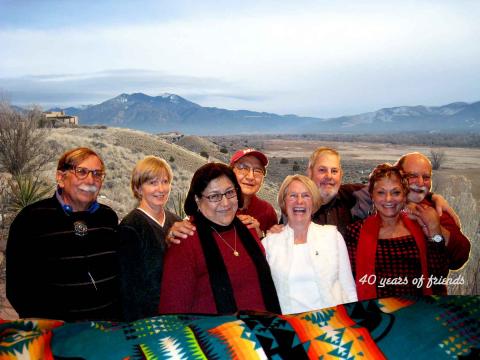A reunion was held in the fall of 2009 at the home of Bob Parker in Taos, New Mexico, with some of the early graduates from the Urban Settlement Design Program at MIT, now known as SIGUS - Special Interest Group in Urban Settlement (the name was changed in 1984 to better reflect both architectural and planning interests of the Program). Attending the two day event were: Earl Kessler (1971) and his spouse, Shari Kessler (also an MIT graduate (1971); Andy Acoya (1970) and his spouse Marie Acoya, and Bob Parker (1970) and his spouse, Deborah McLean; and Reinhard (1970) and his wife Happy. Reinhard remained at MIT following graduation and has headed up the SIGUS Program for many years.
These graduates have remained life long friends and during the reunion discussing the benefits of our education that we received from MIT, how that experience changed our lives and influenced our careers, and perhaps, most important, the values and ethics that we all derived from our time together at MIT. Among those values and ethics was a common thread of service to others and honesty in professional work.
The Program at MIT had been initiated by the renowned architect, planner and teacher, Horacio Caminos, now deceased. John Steffian was an Assistant Professor in the Program at that time and worked with the students in a research and tutorial capacity, along with John Turner as occasional lecturer. It was through Professor Caminos' inspiration and guidance that many of the graduates from the Urban Settlement Design Program began their careers working in the developing country context with housing settlement design and planning policy throughout the World. Other early graduates in the Program included Praful Patel who became VP of the World Bank Southeast Asia and George Gattoni, one of the authors of 'No More Slums' initiative that lead to the founding of the World Bank/UN Habitat Cities Alliance, and Roberto Chavez, a recognized expert in upgrading low income settlements.
The many alumni have formed lasting collegial and social friendships from their time at MIT. This was a magical time at MIT and for most of us remains as one of the seminal times of our lives. One of the things that made the Program so special were the many top thinkers who participated in the program, including John Turner, Hans Harms, Lloyd Rodwin, Donald Schon, William Mitchell, Lisa Peattie, Kevin Lynch, Chester Sprague and others. We all owe a great debt of gratitude to them, to Horacio Caminos and to the larger MIT community.
- From comments by Robert Parker, '70

